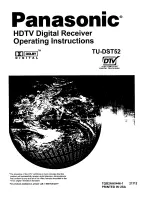
ENGLISH
33
10. System menu overview
In this chapter we will give an overview and explanation of all menu items and settings.
For menu navigation see '6. System menu'.The system menu is accessed by pressing the
SYSTEM MENU (5).The buttons that can be used for navigating through the menus are shown
on the middle display and on the bottom of the TV screen.
When an item is greyed out this means that it cannot be activated/adjusted (yet).
E.g. 'Move preset' in the 'Tuner' menu when no preset stations are stored yet or 'TV out' in
the 'Picture' menu when HDMI enabled equipment is connected.
10.1 Configuration menu
In the 'Configuration' menu you can set basic configuration settings for your DFR9000.
Settings can be made for the following items:
Timer
Selects the delay time after which the receiver automatically switches to Standby.The following
delay times (in minutes) can be selected: 30 Min, 60 Min, 90 Min and 120 Min.The timer will be
set to 'Off' automatically when the receiver is switched to Standby.
Audio delay
Synchronizes the audio and video signal for A/V sources.
(Only available if audio and video exist for
Synchronizing is done in steps of 10 milliseconds from 0 to 150. When setting the audio delay
the currently selected source.)
time, select the A/V source first before opening the system menu.You can then see the picture
on the A/V source and adjust the sound at the same time.The effect can directly be seen on
the TV screen.This setting has an extra menu level, indicated by the highlighted
2
icon at the
bottom of the TV screen and the lit
2
icon in the middle display, allowing you to adjust the
value using
3
and
4
(2). Confirm the adjustment with OK (4) or press
1
to go back to the
previous level without storing the adjustment.You cannot switch to another source while
setting the delay time.
C(entre) Width
Shifts the ratio between left/right and centre speaker output.
Use this option to adjust sound reception if stereo sound is used in DPLIIx Music mode.
C(entre) Gain
Adjusts the centre content in the left/right speaker output.To adjust sound reception if stereo
sound is used in DTS Neo:6 Music mode.
Night mode
Reduces the volume differences between loud and quiet passages.Night mode is available only
for Dolby Digital and DTS signals and only if supported by the source material (e. g. a movie).
Audio in
Selects between 6.1 (7.1) channel input or 3 times stereo input. When selecting 'MULTI-CH'
the 'M-CH IN' input sockets (24) can be used for multichannel connection.
When '3 x STEREO' is selected the 'L/R', 'SL/SR' and 'C/SUB' sockets (24) can be used for
3x stereo connection (CD IN, CDR-IN and AUX IN).
M(ultichannel) Subw(oofer) (Gain)
Analogue multichannel source devices may require different subwoofer gain depending on the
bass management.
Four values can be set for this: 0.0 dB, +5. 0 dB, +10.0 dB and +15.0 dB.
Rec(ord) Audio
In case one the following analogue audio input sockets is connected to a recording device,
this socket needs to be selected when making a recording:
AUDIO:TV IN, GAME IN, DVD IN (25), M-CH IN, CD IN, CD-R IN, AUX IN (24).This will
avoid the recording device from putting it’s audio input signal directly into the output socket it
is connected to (audio feedback loop) which could harm your audio equipment.
Digital out
'Raw':The digital input signal will be put out unmodified in its native form. Only select this
setting if your recording device can handle multichannel input. For this, refer to the
Instructions for Use of your recording device.
'PCM': Pulse Code Modulation. Select PCM for digital recording.
Language
Selects the desired system menu language. Also see 'Selecting your system menu language' in
'6. Setting up the receiver'.
Reset All
Resets all 'System menu' settings to the default factory settings.
Содержание Cineos DFR9000
Страница 1: ...Digital Surround Receiver DFR9000 Instructions for Use English 4 ...
Страница 49: ......
















































